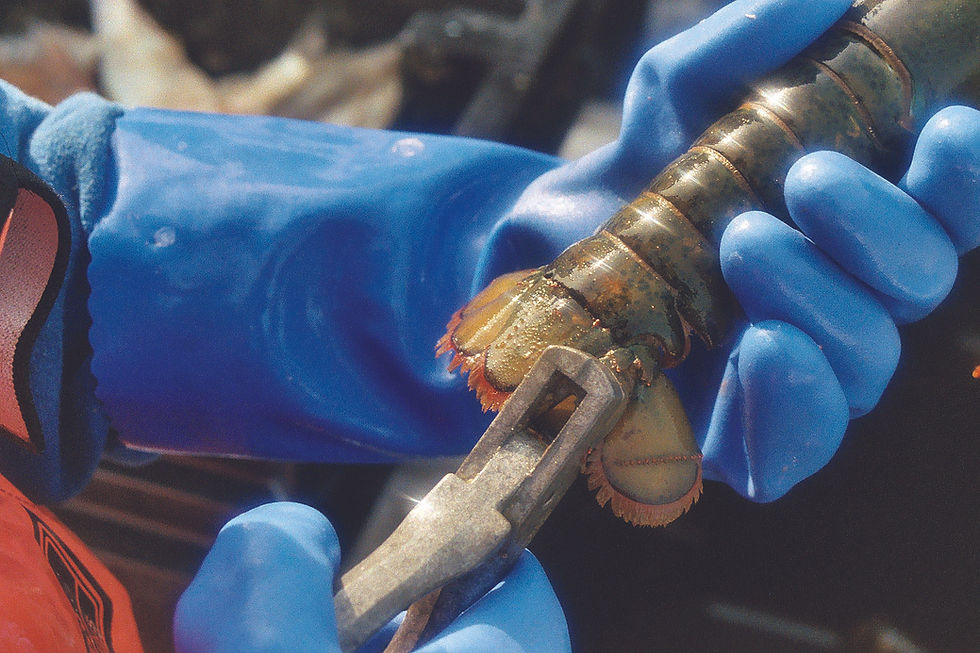An Effective Way to Keep Productive Females in the Water
- Melissa Waterman

- Nov 6
- 4 min read
V-notching remains a key conservation measure taken by Maine lobstermen to help sustain the Gulf of Maine lobster population and it’s a practice that lobstermen have been doing for a very long time. In 2002, V-notching became mandatory to meet the requirements of the Atlantic States Marine Fisheries Commission’s (ASMFC) lobster management plan.

“V-notching eggers returns an otherwise legal-sized female to the ocean to give these proven breeders the opportunity to reproduce again. If we did not have V-notching, as soon as those females hatched their eggs, they would be harvested and taken out of the population,” explained Kathleen Reardon, DMR lead lobster biologist.
Lobstermen have long understood just how valuable V-notching is. A survey conducted by University of Maine professor James Acheson, published in 2010, asked lobstermen how effective they thought various laws were in protecting the lobster population. Of the respondents, 91% said the V-notch requirement was “very effective.” Lobstermen’s commitment to V-notching is supported by the data. According to Department of Marine Resources (DMR), in 2008 82% of all legal-sized egged lobsters examined by sea samplers were V-notched.
“As female lobsters grow in size, the number of eggs they produce increases. Prohibiting harvest to allow females to grow larger allows a higher number of those larger females to reproduce again,” Reardon said. Biologists believe that just 1% of all eggs hatched will reach maturity, thus having more eggs in the water suggests more lobsters could reach legal size.
Research published in 2024 by Alex Ascher at the University of Maine in collaboration with scientists at the Bigelow Laboratory found that female lobster size does matter. “Size correlated positively with a number of egg and larval traits. In brief, larger lobsters in our study produced more eggs, which were both larger and fattier than those produced by smaller lobsters,” Ascher said. “These differences translated to larger larvae which showed evidence of being able to withstand longer periods of starvation.” That’s important since some major food source for larval lobster, such as Calanus finmarchicus, have been declining since 2000.
In 2016, Maine lobstermen landed a record-breaking number of lobsters, 132.6 million pounds in total. It was a sharp rise from the modest 57.2 million landed in 2000. Some lobstermen credit the high rate of V-notching for the steady increase in annual landings that culminated in the 2016 figure.
“It’s more than just coincidence that the high V-notching rates reported in 2008 sea sampling line up with the 2016 record state landings as it generally takes seven to ten years for lobsters to go from the egg stage to legal size,” said Matinicus Island lobsterman Jarod Bray.
Other lobstermen agree. “I believe there is a link between the high landings and the high notch rates,” said Tenants Harbor lobsterman Josh Miller. “I also believe that there were other environmental factors happening that led to elevated larval survival and settlement and increased lobster numbers as well.”
The Gulf of Maine has been warming for some years but the increase in temperature began accelerating in 2010. Reardon’s data show that as landings rapidly increased prior to 2010, the percentage of V-notched legal-sized egged lobsters observed by DMR sea samplers remained steady. “The striking thing in the early years of the data was that as the landings were increasing from 2000 to 2008, the percentage of eggers stayed between 70% and 80%, so lobstermen were notching at a similar rate, even as they saw more,” Reardon said.
That changed, however, as the lobster population abundance escalated. Sea sampling data indicate that the decline V-notching rates coincides with large increase in landings, likely due to time constraints given the high volume of lobsters being handled and need to haul through gear faster. V-notch rates have not improved as landings slowed and the population started to contract after 2016. By failing to V-notch, a lobsterman takes one lobster conservation measure out of the toolbox.
Though Maine’s V-notching rates are lower than they used to be, Maine continues to have a significantly higher V-notch rate than other states, such as Massachusetts.
While V-notching is mandatory, enforcement of the regulation is problematic because officers are not aboard vessels to observe if eggers are being V-notched. Since egged females cannot be landed, it is also not possible for officers to enforce this regulation by checking a lobsterman’s catch. Like much in the lobster fishery, regulations only work through self-compliance or peer pressure from other lobstermen.
The Maine Lobstermen’s Association (MLA) and New England Fishermen’s Stewardship Association (NEFSA) recognize the vital importance of V-notching to the health of the lobster stock and have teamed up to educate lobstermen on the importance of V-notching. “One of the first things I was taught when I started working for the MLA was how important V-notching is to the success of the fishery. Guys really believed in it and were passionate about V-notching as a way to make sure there will always be a healthy fishery for the next generation,” said Patrice McCarron, MLA’s executive director.
The 2025 lobster stock assessment determined that the lobster population has declined by 34% as it adjusts to changes in the environment. “Environmental changes are impacting the number of lobsters in the ocean. V-notching is a simple way to create a buffer to cushion the impact of those environmental changes on the lobster stock,” McCarron said.
“V-notching is our future,” said Bray. “More eggs in the ocean means more lobsters in the future. We are all going to reap rewards from doing it.”



Comments